Life in the Submarine - The Mill Hill Missionaries
Life in the Submarine - The Mill Hill Missionaries
Life in the Submarine - The Mill Hill Missionaries
- No tags were found...
Create successful ePaper yourself
Turn your PDF publications into a flip-book with our unique Google optimized e-Paper software.
<strong>in</strong>troduced at <strong>the</strong> time, became <strong>the</strong> signature tune of <strong>the</strong> Bilenge ya Mw<strong>in</strong>da.Hav<strong>in</strong>g <strong>the</strong> founder and chief <strong>in</strong>itiator of this strik<strong>in</strong>g pastoral <strong>in</strong>itiative at <strong>the</strong>helm of <strong>the</strong> diocese exercised a huge attraction young people all around. Manyof <strong>the</strong> students at Bonkita, where I was teach<strong>in</strong>g, also got <strong>in</strong>volved. Iexperienced this development as a real gift of <strong>the</strong> Spirit and was grateful for<strong>the</strong> opportunity it afforded to acqua<strong>in</strong>t <strong>the</strong> youth with <strong>the</strong> Gospel message <strong>in</strong> alanguage and a manner <strong>the</strong>y could understand and relate to. Regularly everyyear bishop Matondo would write an extensive letter <strong>in</strong> <strong>the</strong> form of a brochureto <strong>the</strong> Bilenge ya Mw<strong>in</strong>da all over <strong>the</strong> country. It took a while to fully appropriate<strong>the</strong> thoroughly African process of <strong>in</strong>itiation which lay at <strong>the</strong> roots of <strong>the</strong> methodproposed by bishop Matondo. <strong>The</strong> fact that most young people had noawareness or experience of traditional tribal <strong>in</strong>itiation also did not help. But atleast everyone could recognise <strong>the</strong> approach as truly African.Africa has a rich oral tradition. In Central Africa <strong>the</strong>re are no written sourcespredat<strong>in</strong>g <strong>the</strong> colonial period. Important historical events were handed on byword of mouth and committed to memory with amaz<strong>in</strong>g accuracy. A well-knownBelgian scholar, Jan Vans<strong>in</strong>a, has been able to trace back <strong>the</strong> l<strong>in</strong>eage of <strong>the</strong>K<strong>in</strong>gs of <strong>the</strong> Bakuba K<strong>in</strong>gdom <strong>in</strong> Congo to <strong>the</strong> sixteenth century us<strong>in</strong>g oralsources. David van Reybrouck <strong>in</strong> recent his history of Congo, published toco<strong>in</strong>cide with <strong>the</strong> 50th anniversary of <strong>the</strong> country’s <strong>in</strong>dependence, makesextensive use of <strong>in</strong>formants.Similarly Bishop Matondo was conscious of be<strong>in</strong>g heir to a culture centredaround ‘le Verbe’, as <strong>the</strong> French expression goes. “And <strong>the</strong> Word was madeflesh”. He was an excellent orator. His sermons and conferences were alwayswell prepared. I often saw him walk<strong>in</strong>g up and down <strong>the</strong> veranda of hisresidence’ th<strong>in</strong>k<strong>in</strong>g ‘aloud’ to test and develop <strong>the</strong> flow of an sermon or a talk.His lively sermons <strong>in</strong> true African style would be peppered with proverbs,stories, an occasional song and plenty of rhetorical questions to which <strong>the</strong>audience would respond <strong>in</strong>stantly as <strong>the</strong>y would at a village ga<strong>the</strong>r<strong>in</strong>g. Oftenhe would be carried away by his own enthusiasm, sweat<strong>in</strong>g profusely andgesticulat<strong>in</strong>g wildly to <strong>the</strong> po<strong>in</strong>t of almost los<strong>in</strong>g his mitre (bishops wear <strong>the</strong>irmitre when <strong>the</strong>y preach!). African oratory is generous <strong>in</strong> its use of time too. AEuropean style ten m<strong>in</strong>ute sermon leaves most Congolese ‘hungry’. AEucharist celebrated <strong>in</strong> <strong>the</strong> Zaïrean rite typically lasts two hours or more – <strong>the</strong>sermon tak<strong>in</strong>g half an hour at least. <strong>The</strong> art of exuberant celebration – religioncan be fun! – is one of Africa’s most precious contributions to <strong>the</strong> universalChurch, <strong>in</strong> my estimation. <strong>The</strong> longest celebration I ever attended was anEaster Vigil at Basankusu Ca<strong>the</strong>dral which started at 8 pm and f<strong>in</strong>ished wellpast midnight! Some <strong>in</strong>veterate smokers among my fellow missionaries would




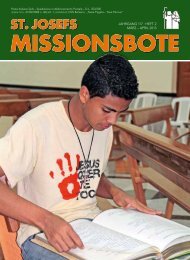
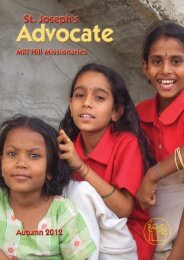


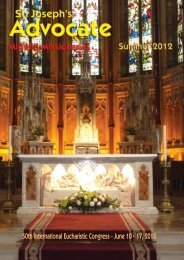
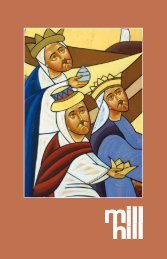
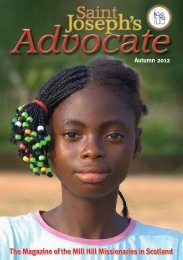

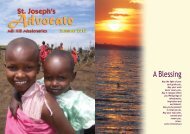

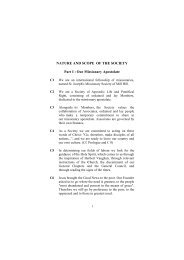

![Summer 2012 [pdf] - The Mill Hill Missionaries](https://img.yumpu.com/43011464/1/184x260/summer-2012-pdf-the-mill-hill-missionaries.jpg?quality=85)